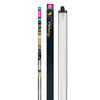
The Importance of UVB Lighting for Reptiles and How to Select the Right UV Light
, by Daniel Davies, 4 min reading time

, by Daniel Davies, 4 min reading time
Part of the Herp Hub Blog Series
When it comes to keeping reptiles healthy in captivity, providing proper lighting is one of the most critical factors. Among the different types of light reptiles require, UVB lighting plays a vital role in their overall health and well-being. Here, we’ll explore why UVB light is essential for reptiles and provide a guide to selecting the right UV light for your pet.
UVB, or ultraviolet B light, is a specific wavelength of light that helps reptiles synthesize vitamin D3 in their skin. Vitamin D3 is essential for the absorption and metabolism of calcium, which in turn supports:
Bone Health: Proper calcium metabolism prevents metabolic bone disease (MBD), a common and debilitating condition in captive reptiles.
Muscle Function: Adequate calcium levels ensure proper muscle function and prevent issues like tremors or lethargy.
Immune System Support: UVB exposure helps maintain a robust immune system, keeping your reptile healthy.
In their natural habitats, reptiles receive UVB light directly from the sun. In captivity, it’s crucial to replicate this exposure with artificial UVB lighting to ensure their health and longevity.
Not all UVB lights are created equal, and different reptiles have varying requirements based on their species, size, and habitat. Here are some factors to consider:
Reptiles come from diverse environments, and their UVB needs depend on their native habitat:
Desert-Dwelling Reptiles: Species like bearded dragons and uromastyx require high levels of UVB (10-12% UVB output).
Forest or Jungle Reptiles: Chameleons and crested geckos thrive with moderate levels of UVB (5-7% UVB output).
Nocturnal Species: While nocturnal reptiles like leopard geckos require less UVB, minimal exposure can still benefit their overall health.
There are different types of UVB bulbs available, and the right one depends on your enclosure setup and reptile’s needs:
Tube Bulbs: Ideal for larger enclosures as they provide an even distribution of UVB across a wide area. Linear T5 or T8 bulbs are popular choices.
Compact Bulbs: Suitable for smaller tanks or localized UVB exposure but may not cover a wide area.
Mercury Vapor Bulbs: Combine heat and UVB in one bulb, perfect for desert species but may not fit all enclosures due to high heat output.
UVB light intensity diminishes with distance, so it’s essential to follow the manufacturer’s recommendations for placement. Typically:
T5 bulbs can be placed 12-24 inches from your reptile.
Compact bulbs are effective within 6-12 inches.
Avoid placing UVB lights above a glass or plastic cover, as these materials block UVB rays.
UVB bulbs lose their effectiveness over time, even if they still emit visible light. Most bulbs need replacement every 6-12 months. Always check the manufacturer’s guidelines.
To ensure your reptile is receiving adequate UVB exposure, invest in a UVB meter. This tool measures the UVB output and allows you to monitor the light’s intensity over time.
Combine UVB with Proper Heating: UVB lighting works best when paired with appropriate heat sources, as reptiles are ectothermic and rely on external heat to regulate their body temperature.
Create a Light Cycle: Mimic natural day and night cycles by providing 10-12 hours of light per day, depending on your reptile’s natural environment.
Monitor Your Reptile’s Behavior: Signs of inadequate UVB include lethargy, poor appetite, and abnormal bone growth. If you notice these symptoms, reevaluate your lighting setup.
Providing the correct UVB lighting is a cornerstone of responsible reptile care. By understanding your reptile’s natural habitat and selecting the appropriate UVB bulb, you can create an environment that supports their health and allows them to thrive in captivity. Regularly monitor and maintain your lighting setup to ensure your reptile gets the UVB they need for a long and healthy life.
Need help selecting the right UVB light for your pet? Visit us at World of Exotics, where our reptile specialists can guide you in choosing the best lighting solutions for your scaly companion!